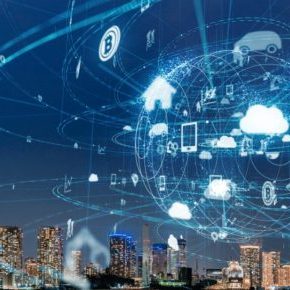
Internet of things, or IoT, is a system of integrated and interrelated computing devices, digital machines, objects, and mechanical codes. They are provided with unique identifiers that are embedded with sensors, processing ability, software, and various technologies.
IoT consists of web-enabled physical objects to connect and exchange data with other devices and systems over the internet. These can be from ordinary household objects to sophisticated industrial tools.
As time passes by, IoT is becoming one of the most important technologies in the upcoming century.
A thing in the Internet of Things can be a farm animal, a dairy product, biochip transponder or a heart monitor implant, built-in sensors in automobiles, or any other man-made object that can be assigned an Internet Protocol (IP) address and can transfer data over a network.
Example of an Internet of Things device
Every product can be transformed into an IoT device if it gets connected to the internet and can communicate information.
A smart thermostat sensor can be made just by connecting it to the digital framework of your remote. Any product and service can be included in the Internet of Things when its informational data comes online.
A growing number of IoT devices are made for consumer usage, including home automation, health, and appliances with remote controlling capabilities. IoT devices are becoming a large part of home automation including lighting, heating and air conditioning, security systems, and camera settings.
In Medical and healthcare, IoMT or the Internet of Medical Things is an application for medical and health-related purposes, data collection and analysis along with monitoring. A digitized healthcare system collects and monitors medical resources for availability and healthcare services.
Benefits of Internet of Things
The implementation of IoT has led to a system of interconnected devices that collect, analyze and monitor data from the surrounding environment. This analysis helps us to perform better and make more informed decisions. The basic definition of IoT is taking all the physical parts and things in the world and connecting them all to one platform, the internet.
To clarify this it is important to understand the benefits of connecting things to the internet. Let’s look into the benefits of IoT –
- Monitoring Data – The most necessary advantage of IoT is that it monitors all the information about the product. It helps us to know the exact quality or the number of minerals in that one cup of water. It also provides data that could not previously be possible to track.
- Efficient Operations – The process of data pouring through IoT makes automation effortless and efficient. IoT makes automation devices speedy, allowing employees to invest their effort and time into more productive issues.
- Automation with Control – As all physical objects are connected to the digital platform, control also becomes digital, the information is stored in the central platform. This huge amount of automation of data without any interference gives way to more control and provides faster outputs.
- Adapting to New Technologies – As IoT is forever changing, its changes are minimal compared to other technologies. For complicated updates, IoT welcomes modifications as it would be difficult to keep track.
Disadvantages of IoT
IoT is a complete network of interconnected and embedded devices that collect and monitor data without the need for any human interaction over the internet.
Let’s look into a few of the disadvantages IoT may cause –
- Breach of Data – IoT has access to all the data of the product and each information is stored on the internet. This exposes the data to outside entities. The data breach is a stressful issue and companies also worry about compromising their clients’ information.
- Complexity in Operation – IoT manages a plethora of tasks with ease, a lot of complex operations are carried behind the scenes. Even if there is a single calculation done wrong this will affect the rest of the process. This is to keep in mind that mistakes in IoT are not easy to debug.
- Compatibility – As products and devices from different manufacturers are interconnected through IoT, the issue of monitoring and tagging increases. This technical problem may persist if each organization doesn’t have a common standard.
Conclusion
There are numerous real-time applications of the internet of things, ranging from consumer needs, healthcare, enterprise IoT to manufacturing and industrial IoT. IoT is spread across numerous verticals, including security systems, automotive, medicine, telecom, energy, and home requirements.
In agriculture as well, IoT-based farming systems help to monitor the various needs for crop production. IoT is also instrumental in automating the complete irrigation system.
IoT also increases the efficiency of the production system, by collecting real-time data and analysis of the data. IoT promises to make our homes and offices smarter, measurable, and efficient.

